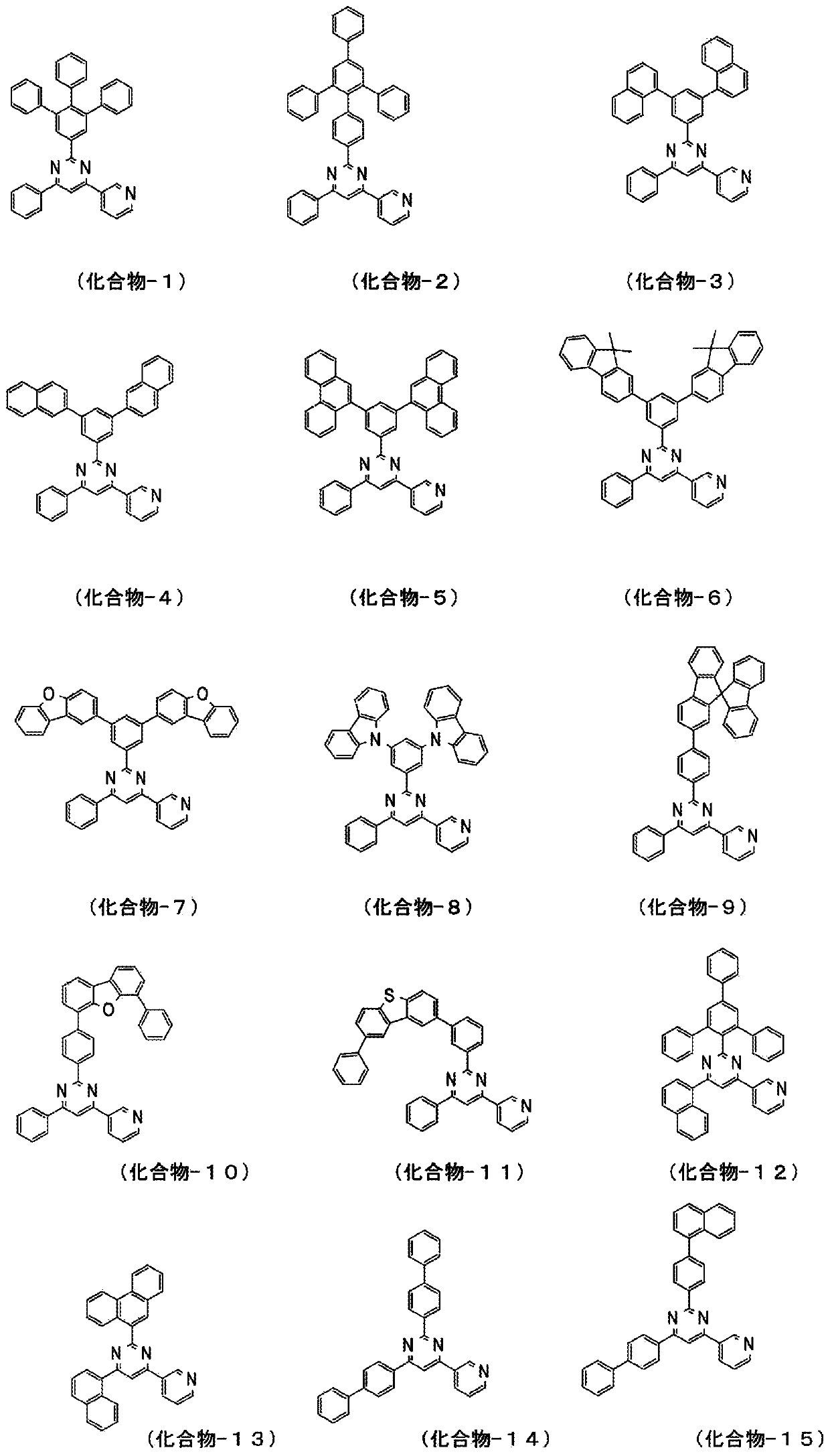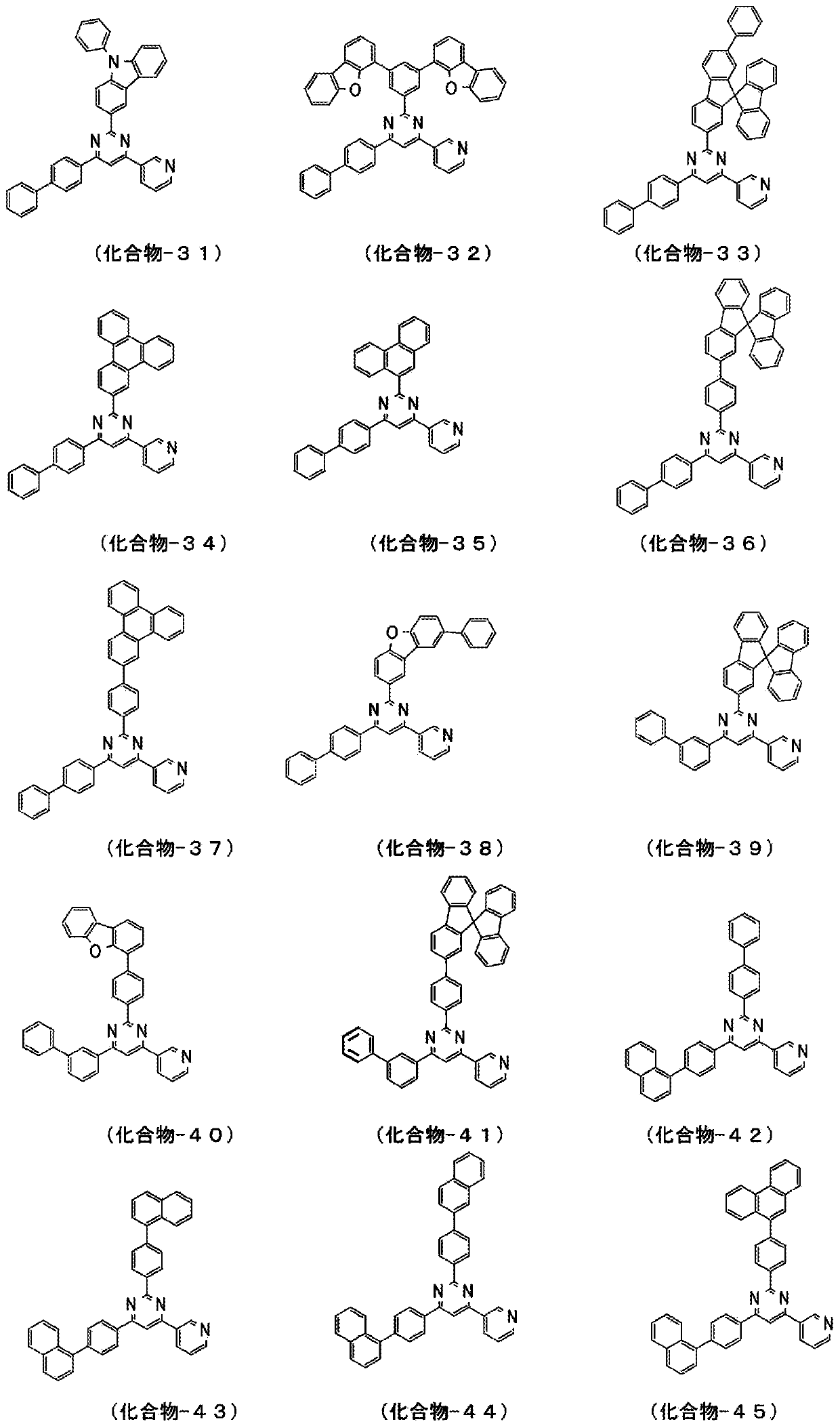Compound having pyrimidine ring structure and organic electroluminescent element
A technology of pyrimidine ring and compound, which is applied in the field of compounds with pyrimidine ring structure and organic electroluminescence elements, can solve the problems of insufficient film stability, insufficient hole blocking function, and inability to fully exert the function, etc.
- Summary
- Abstract
- Description
- Claims
- Application Information
AI Technical Summary
Problems solved by technology
Method used
Image
Examples
Embodiment 1
[0119]
[0120] 6-(biphenyl-4-yl)-2-chloro-4-(pyridin-3-yl)-pyrimidine: 7.5 g, 4-(phenanthrene-9-yl)-phenylboronic acid: 7.2g, four (triphenylphosphine) palladium (0): 0.5g, potassium carbonate: 6.0g, in toluene, ethanol, H 2 O mixed solvent under reflux and stirred overnight. After cooling naturally, the organic layer was extracted by a liquid separation operation, and then concentrated under reduced pressure. Purify the obtained crude product by column chromatography (carrier: silica gel, eluent: toluene / ethyl acetate) to obtain 6-(biphenyl-4-yl)-2-{4-(phenanthrene-9 White powder of -yl)-phenyl}-4-(pyridin-3-yl)-pyrimidine (compound-17): 1.5 g (yield 12%).
[0121] [chemical 6]
[0122]
[0123] The structure of the obtained white powder was identified using NMR.
[0124] use 1 H-NMR (CDCl 3 ) detected the following 27 hydrogen signals.
[0125] δ(ppm)=9.55(1H), 8.90(2H), 8.85(1H), 8.82(1H), 8.78(1H), 8.70(1H), 8.46(2H), 8.15(1H), 8.04(1H), 7.97(1H), 7.86(2H), 7...
Embodiment 2
[0127] Synthesis of
[0128] Charge 6-(biphenyl-4-yl)-2-chloro-4-(pyridin-3-yl)-pyrimidine in the reaction vessel: 5.0 g, 2-(9,9-diphenyl[9H]fluorene ) boric acid: 6.8g, tetrakis (triphenylphosphine) palladium (0): 0.3g, potassium carbonate: 2.4g, in toluene, ethanol, H 2 O mixed solvent under reflux and stirred overnight. After cooling naturally, the organic layer was extracted by a liquid separation operation, and then concentrated under reduced pressure. By purifying the obtained crude product by column chromatography (carrier: silica gel, eluent: toluene / ethyl acetate), 6-(biphenyl-4-yl)-2-(9,9-diphenyl Light gray brown powder of [9H]fluoren-2-yl)-4-(pyridin-3-yl)-pyrimidine (compound-26): 6.6 g (yield 73%).
[0129] [chemical 7]
[0130]
[0131] The structure of the obtained light gray-brown powder was identified using NMR.
[0132] use 1 H-NMR (DMSO-d6) detected the following 31 hydrogen signals.
[0133] δ(ppm)=9.63(1H), 8.81(2H), 8.77(1H), 8.69(2H), 8.58(2H...
Embodiment 3
[0135] Synthesis of
[0136] Charge 6-(biphenyl-4-yl)-2-chloro-4-(pyridin-3-yl)-pyrimidine in the reaction vessel: 7.0 g, 2-(9,9'-spirobis[9H]fluorene ) boric acid: 8.1g, tetrakis (triphenylphosphine) palladium (0): 0.5g, potassium carbonate: 3.4g, in toluene, ethanol, H 2 O mixed solvent under reflux and stirred overnight. After natural cooling, the organic layer was extracted by a liquid separation operation, and then concentrated under reduced pressure. Purify the obtained crude product by column chromatography (carrier: silica gel, eluent: dichloromethane / ethyl acetate) to obtain 6-(biphenyl-4-yl)-4-(pyridine-3- White powder of yl)-2-(9,9'-spirobis[9H]fluoren-2-yl)-pyrimidine (compound-27): 5.5 g (yield 43%).
[0137] [chemical 8]
[0138]
[0139] The structure of the obtained white powder was identified using NMR.
[0140] use 1 H-NMR (CDCl 3 ) detected the following 29 hydrogen signals.
[0141] δ(ppm)=9.37(1H), 8.85(1H), 8.75(1H), 8.46(1H), 8.26(2H), 8.06(1H)...
PUM
| Property | Measurement | Unit |
|---|---|---|
| electron work function | aaaaa | aaaaa |
| glass transition temperature | aaaaa | aaaaa |
| thickness | aaaaa | aaaaa |
Abstract
Description
Claims
Application Information
 Login to View More
Login to View More - R&D
- Intellectual Property
- Life Sciences
- Materials
- Tech Scout
- Unparalleled Data Quality
- Higher Quality Content
- 60% Fewer Hallucinations
Browse by: Latest US Patents, China's latest patents, Technical Efficacy Thesaurus, Application Domain, Technology Topic, Popular Technical Reports.
© 2025 PatSnap. All rights reserved.Legal|Privacy policy|Modern Slavery Act Transparency Statement|Sitemap|About US| Contact US: help@patsnap.com



